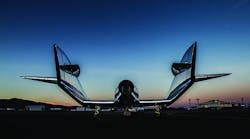Champagne, caviar and seared tuna will be on the menu for Virgin Galactic astronauts-in-training when they arrive at the company’s new home in the desert scrublands of southern New Mexico. As they gaze out at the mountains east of the otherworldly structure, a master of espresso arts will dose out shots from a barista island, accompanied by multiple forms of dairy and dairy alternatives, including oat milk, of course.
As for when the actual flights will begin, no one’s saying yet.
Virgin Galactic executives offered journalists a tour of their chic new headquarters and customer center this week at Spaceport America, declaring the facility “operationally ready” for space tourism. After 15 years of struggle, including the fallout of a fatal accident and a subsequent spacecraft redesign, company officials were exuberant.
“The problem with history is that you don’t really [comprehend] it while it’s happening, but here we are and it’s happening—the launch of commercial space flights,” George Whitesides, Virgin Galactic’s chief executive officer, said Thursday at the spaceport.
The company declined to say when customer flights would begin, following years of faulty prognostication from Virgin Group founder Sir Richard Branson, who has said he will be among the first to fly. Virgin has completed two test flights into space since December, with additional glide and powered flights planned from the new operating base.
The $200 million spaceport complex was designed by UK architects Foster + Partners, with the exterior completed several years ago; the interior remained unfinished until recently.
The interior design reflects the Virgin brand and Branson’s personal approach to hospitality, executives said. Earth tones and warm fabrics on the ground floor (dubbed Gaia) give way to a “clinical, lighter feel” on the second (called Cirrus), explained Jeremy Brown, the company’s lead architectural designer.
The second story has employee workspaces, largely for meals and socializing, and mission control. A third floor “astronaut lounge” will be completed early next year. Part of mission control’s flight-day duties, President Michael Moses explained, will be “notifying someone about when to chill the Champagne for the party after the flight.”
Before the bubbly flows, customers will have three days of training to prepare for the G-forces and learn how to move in microgravity. Launches will happen on the morning of their fourth day.
Even astronauts, however, can’t escape the rigors of a daily, ground-based commute. The spaceport is about 55 miles northeast of Las Cruces, New Mexico, where customers will stay at the posh Hotel Encanto de Las Cruces. Virgin is also exploring ways to lure a new upscale resort closer to the spaceport, said Stephen Attenborough, Virgin Galactic’s commercial director. It’s also possible that any new resort for the spaceport could be branded as a Virgin Limited Edition property. The Virgin unit operates seven upscale resorts, including the 74-acre Necker Island in the Caribbean where Branson spends much of his time.
Slightly more than 600 people from 60 countries have paid $250,000 for 90 minute rides into space. To keep the waiting list reasonable, Virgin has stopped taking reservations until commercial flights begin.
As the Virgin fleet grows, so too will its cadre of pilots and flight schedule. Spacecraft will depart not quite daily, but “certainly very frequently,” said Attenborough.
For now, Virgin remains focused on finishing final flight preparations. The carrier aircraft VMS Eve relocated from California to New Mexico on Aug. 12 and has begun readiness flights. Testing includes air traffic control communications and maneuvers that simulate how the aircraft will drop the attached VSS Unity spaceship at almost 50,000 feet. Unlike Virgin’s previous flights in the military airspace above Mojave, the New Mexico flights will operate in part above commercial air traffic, requiring more airspace coordination with Federal Aviation Administration controllers.
Two additional spaceships are in production at Virgin’s Mojave, Calif. facility, with plans for a fleet of five and two carrier aircraft.
Human workers are also on the move. Virgin Galactic’s transplanted workforce, mostly from California, is about 90 strong now with an additional 50-60 still to come. Their arrival represents a resurrection of New Mexico’s $200 million investment in the endeavor, one that had garnered no shortage of derisive assessments. Each setback—such as the fatal 2014 crash of a Virgin Galactic spaceship or SpaceX’s decision not to use the site—signaled the likely failure of New Mexico’s desert adventure. Local politicians were quick to express their relief in public.
Virgin Galactic’s progress has become integral to economic development for the state, said New Mexico Lt. Governor Howie Morales, who participated in the event Thursday.
By Justin Bachman










